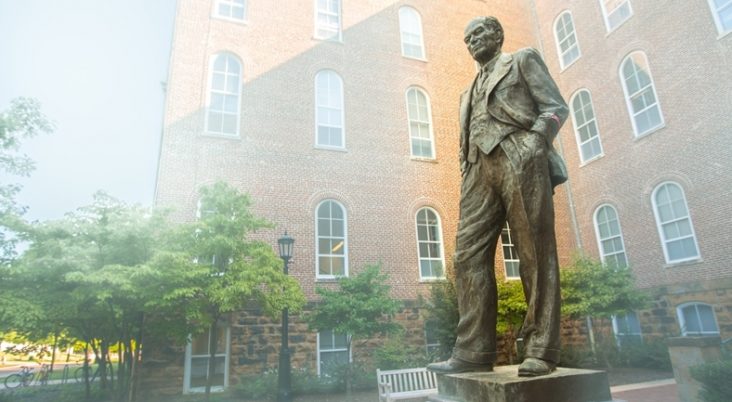UA trustees keep Fulbright College name, statue in place
by July 28, 2021 4:49 pm 1,008 views

J. William Fulbright statue on the University of Arkansas campus.
The University of Arkansas Board of Trustees approved Wednesday (July 28) a resolution to leave the statue of former U.S. Sen. J. William Fulbright where it is on the University of Arkansas at Fayetteville campus, but to provide “historical context” for the monument to the longtime leader.
Fulbright’s legacy has come under increased scrutiny in recent months.
Fulbright served one term in the U.S. House of Representatives and served in the U.S. Senate from 1945 until his resignation in 1974. Fulbright is the longest-serving chairman in the history of the Senate’s Committee on Foreign Relations. The Fulbright Program was created in 1946 by Sen. Fulbright and is managed by the Bureau of Educational and Cultural Affairs of the United States Department of State. More than 400,000 “Fulbrighters” have participated in the program which now operates in more than 160 countries.
However, Fulbright had a mixed history with civil rights and race relations. Part of that history includes his opposition to the Brown v Board of Education decision, which brought a legal end to racial segregation in public schools. He opposed the Voting Rights Act, but would in 1970 approve a five-year extension of the act.
That conflicting legacy led to calls for the Fulbright College and his statue on the UA flagship campus to be removed.
UA System President Donald Bobbitt recommended to the board keeping the college’s name and Fulbright’s statue where it is, in part due to a state law that could complicate moving the statue.
“My review of the letter and discussions with stakeholders have led me to agree with the recommendation to retain the name of Fulbright College and agree with the need to contextualize the Fulbright statue in a way that presents the full legacy of Senator Fulbright. However, since Act 1003 of 2021 prevents removing or relocating monuments on public property absent receipt of a waiver from the Arkansas History Commission, I believe the statue should be contextualized in its current location. If a path presents itself at a later time to consider the relocation of the statue that is consistent with state law, the Board can revisit this issue,” Bobbitt said.
The resolution approved by the UA board of trustees “directs that the J. William Fulbright statue remain in its current location and that the University add contextualization to the statue that affirms the University’s commitment to racial equality and acknowledges Senator Fulbright’s complex legacy, including his record on international affairs, Civil Rights legislation, and racial integration.”
A spokesman for the university system said the historic “contextualization” will be a campus project directed by UAF officials.
In other board news, trustees approved the removal of the name of the Charles Hillman Brough Commons dining facility. Brough was Arkansas’ 25th governor and served from January 1917 to January 1921. Brough is connected to what is known as the Elaine Massacre in the summer of 1919.
Poor, black sharecroppers in Phillips County had tolerated low wages and terrible work conditions since the end of the Civil War, but after World War I ended they’d had enough. Tensions between blacks and whites simmered throughout the country during the summer of 1919. The disgruntled sharecroppers met late night Sept. 30, 1919, in a church in the small town of Elaine. A group of white men aware of the meeting went to the church. Gunshots were exchanged and a white law officer was killed.
The tragic event is considered by some historians to be the worst racial clash in U.S. history that left five whites dead and potentially hundreds of blacks. Brough not only directed federal troops to Elaine but accompanied them when they rounded up and murdered some of the black residents.
